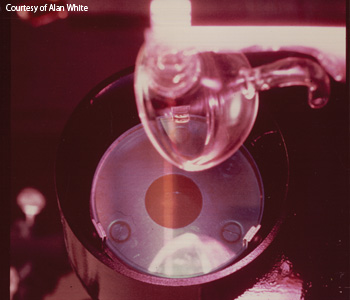 The business end of the first visible red HeNe laser. The beam is visible as a faint red line reflected in the mirror and as a red spot behind the mirror.
The business end of the first visible red HeNe laser. The beam is visible as a faint red line reflected in the mirror and as a red spot behind the mirror.
In many ways, “coherent light” was a contradiction in terms during the years preceding the demonstration of the ammonia maser by Gordon, Zeiger and Townes in 1954. The new device was a conceptual breakthrough, proving that inverted state populations of molecules could amplify and generate useful amounts of coherent ultrashort microwaves by stimulated emission. For the first time, scientists and engineers could begin to think of producing light waves, which were just as coherent as the radio waves generated by electronic circuits. However, it was not at all obvious before 1954 that the ammonia maser experiment would succeed. Townes has noted that at least one prominent scientist expressed serious doubts at the time.
In 1958, four years after the initial success, Schawlow and Townes showed theoretically how the microwave results could be extended to visible and infrared light. But it was clear that making the transition to shorter wavelengths was not going to be simple or straightforward. The critical missing element was the gain medium. Nature, it seemed, preferred thermal equilibrium nearly everywhere, so finding an atomic or molecular medium in which population inversion could be induced at optical frequencies was considered a nontrivial task.
Coherent light generation became very much the buzz after the publication of the 1958 Schawlow/Townes paper. Among the first candidates proposed for a gain medium was ruby, a chromium-doped crystal of aluminum oxide. There were arguments for and against using this material, but the matter was finally settled in 1960 by Ted Maiman, who was able to demonstrate pulsed lasing in ruby at 694.3 nm using a powerful photographic flash lamp to achieve population inversion.
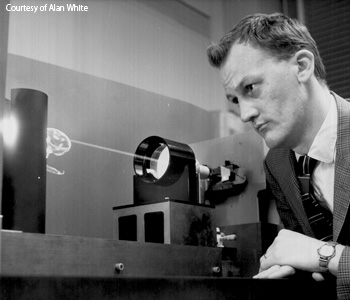 Dane Rigden of Bell Labs examines the bright red beam of coherent light emanating from the helium-neon gaseous optical maser.
Dane Rigden of Bell Labs examines the bright red beam of coherent light emanating from the helium-neon gaseous optical maser.
The dawn of continuous lasing
Then, in late 1960, Javan, Bennett and Herriott showed that a radio frequency discharge in a mixture of helium and neon gases at low pressure could be used to invert a pair of levels in the neon atom and obtain optical gain and oscillation in the infrared at 1.15 µm. This new infrared laser was of tremendous interest to Bell Labs because it offered what the Bell system really needed—a continuous source of coherent light with potentially very large bandwidth.
The successful demonstration of the infrared gas laser created great interest at communication laboratories throughout the world, so it was no surprise when the U.S. Army Signal Corps approached Bell Labs about making an infrared HeNe laser for the Signal Corps’ use. Eventually, the request landed on the desk of our department head at Bell Labs, Ray Sears, who passed the proposal to Dane Rigden and me. Dane was knowledgeable about optics and I had been working with gas discharges for several years, so it seemed to be a good fit.
The device requested by the Signal Corps would be similar to the original HeNe laser but improved with external concave mirrors, Brewster windows and a DC discharge. Like most scientists, we were very interested in learning more about the new light generator, so we jumped at the Signal Corps’ offer, seeing it as a great opportunity. The Bell Labs group originally approached by the Signal Corps helped us to get started by providing Brewster windows and infrared mirrors. Although our glass shop had to learn some new tricks, it wasn’t long before we had the first tube up and running.
Bumps in the road
Mirror alignment was our first problem, even though we were using a relatively easy-to-align concave mirror cavity. Eventually we adopted a mirror scanning technique with an IR detector monitoring the output. Within a few hours, the tube was generating a few milliwatts of power at 1.15 µm. While this was encouraging, we were still faced with minor cathode problems, so we made some design changes. As we waited for a new tube to be made, we went back to the lab and explored some of the properties of the existing tube, hoping to learn more about what was going on in the discharge.
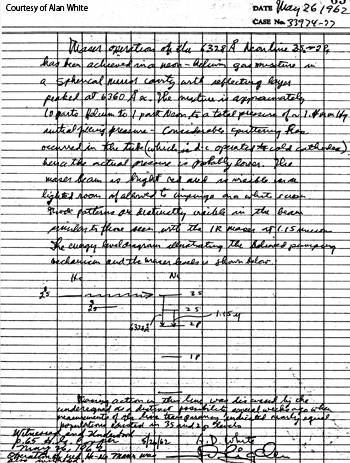 Notebook entry marking the first operation of the red HeNe gas laser. At the time, Bell Labs scientists still used the awkward term "optical maser."
Notebook entry marking the first operation of the red HeNe gas laser. At the time, Bell Labs scientists still used the awkward term "optical maser."
We also had some half-baked ideas about enhancing power output by combining optical pumping with discharge pumping. From the beginning, we were eager to take spectral scans of the spontaneously emitted light from the tube with fillings of helium, neon and the two combined. At the time, this seemed like an obvious thing to do. Our only spectrometer was limited to the visible region of the spectrum, so that is where the scans were made.
The spectral scans were fascinating. They seemed loaded with useful but difficult-to-decipher information. The output from the scanning spectrometer was sent to a chart recorder, enabling us to obtain a record of spectral changes in both gas species from 3,800 to just beyond 7,000 Angstroms. There were major intensity changes in dozens of lines, mostly in the neon spectrum but some in the helium spectrum as well. Our source material on spectral lines and atomic energy levels of the rare gases was Crosswhite and Dicke’s chapter 7G of the 1957 edition of the AIP Handbook, and an extensive tabulation of noble gas energy levels and emission lines compiled from various sources and arranged on a common energy level diagram (possibly by C. Moore).
One of the neon 3s-2p (Paschen notation) transitions in the visible 632.8 nm wavelength immediately caught our attention. In the spectrum of pure neon, this was a weak red line. However, the line’s intensity increased by a factor of 50 or more for the same discharge current when we added helium. When we superimposed the helium energy level diagram on the neon energy level diagram, we immediately recognized the probable cause for the enhancement; the upper helium 21S metastable level coincided closely with the 3s2 level of neon. Except for the differences in magnitude, this was remarkably similar to the energy coincidence between the 23S helium metastable level and the 2s2 level of neon, which was the source of inversion for the 1.15-µm laser.
 (Left to right) Dane Rigden, Alan White and Bill Rigrod having a discussion in the laser lab at Bell Labs, 1963. The long HeNe laser on the bench is emitting about 80 milliwatts of power at 632.8 nm.
(Left to right) Dane Rigden, Alan White and Bill Rigrod having a discussion in the laser lab at Bell Labs, 1963. The long HeNe laser on the bench is emitting about 80 milliwatts of power at 632.8 nm.
Getting somewhere
It was at that point that we began to suspect that we were on to something. We knew nothing about the lifetime of the 3s2 level, but the similarity between the inversion mechanism for the 1.15-µm line and what we observed as enhancement of the 632.8-nm line was close enough to warrant further investigation. Our first thought was that the remarkable enhancement of the red 632.8-nm line in neon must have been noted before and might have been published, so we did a literature search.
The search came up empty, but it seemed unlikely that this effect had never been noticed before. We were also aware of the very lengthy and detailed studies that Bennett and Javan had done of the neon 2s and 2p levels before they decided that they were candidates for inversion, but we had neither the time nor access to the proper equipment for duplicating those studies with the 3s2 level.
At that point, the simplest thing to do was to attempt to measure gain (or loss) using a phase sensitive amplifier and a chopped 632.8-nm light source. The outcome of those measurements was marginal at best, but they did confirm that the discharge plasma was highly transparent, if not necessarily amplifying, for 632.8-nm light. The next step seemed obvious: Obtain a pair of suitably coated mirrors and two mirror mounts, and look for oscillation at 632.8 nm.
This brought up a rather sticky problem. Up until now, we were working on our own time—evenings and weekends with no direct monetary support from the Labs. Now we needed two dielectric coated concave mirrors. The mirror blanks and mounts were not a problem; we got them from Edmund Scientific for a few dollars. But getting the blanks coated by Bausch and Lomb was going to be expensive, costing perhaps as much as $200.
At that point we had to tell our supervisor, Gordon Cooper, what was going on. Fortunately, he was in a good mood that day, and he signed the order and kept silent about our extracurricular activities. When ordering the mirrors, Dane was careful about specifying the wavelength of peak reflectivity. He picked 636 nm, which was close enough to the desired wavelength for high reflectivity but not so close that others could guess what we were up to.
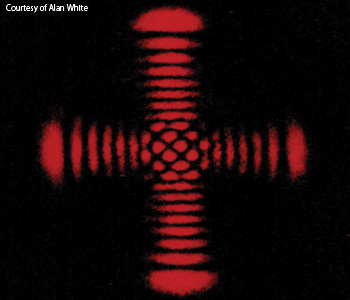 Single-mode laser pattern from the red HeNe laser.
Single-mode laser pattern from the red HeNe laser.
It took about three to four weeks for the mirrors to be delivered from B&L. There was already a tube on the vacuum station, but it was large bore (6-7 mm) and we were fairly certain that a smaller bore tube would have higher gain. Nonetheless, it seemed worth an attempt, so we asked a colleague, Darwin Perry, to come in and help us when we returned to the labs that evening. We mounted the two new mirrors, flushed the tube several times to get it clean, filled it with a helium-neon mixture to what we judged was the right pressure and started the discharge.
Making it happen
Dane, impatient to get the mirrors aligned, put his eye up close to the exit port of the output mirror (!) to see if he could spot some visual indication of alignment. His intuition was correct: As both mirrors were individually brought into alignment, light coming out along the tube axis brightened considerably. None of us knew what to expect looking down the tube axis, but after awhile Dane casually mentioned that he could see intermittent sparkles of bright red light that looked like brilliant little red stars.
This was interesting; it wasn’t anything like the mode patterns he expected to see based on videos of the 1.15-µm laser output taken with an IR video camera. Suddenly, I realized that what he was seeing was the laser beam coming from an apparently distant point source. His eye had focused the nearly planar wavefront to a point, just as it does with light from a distant star. I looked for myself and confirmed Dane’s observation.
Both of us realized at the time that looking down the tube axis was not the safest way to confirm lasing, but it was clear that this particular laser was not a hole burner so we weren’t too concerned. When projected on the wall, the bright red beam was intermittently visible as the mirrors went into and out of alignment due to ambient vibrations. The color was unlike anything we had ever seen before—extraordinarily brilliant and totally saturated with a strange speckle-like appearance that we later learned was associated with the coherence properties of laser light.
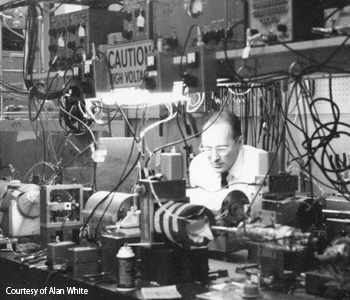 Alan White works on a red HeNe laser in a very cluttered laboratory.
Alan White works on a red HeNe laser in a very cluttered laboratory.
After a few minutes, the discharge became erratic, and it seemed that the tube was on the verge of failing. I shouted down to Darwin Perry on the floor below to come up quickly and witness the lasing before the tube died. Later, he told us that he thought someone had been badly injured because of the urgency in my voice.
A minute or two later, the tube went dead, but not before all of us had seen it lase. It was the first continuous visible laser, and we were the first three people on earth to witness it. Nowadays, of course, with hundreds of different visible spectral lines lasing, our experience that evening seems insignificant.
At the time, we felt a continuous visible laser was an important development, but its true significance didn’t sink in until a day or so later after we made a new tube with higher power. It produced a much brighter and more stable beam that could be projected hundreds of feet down the hall with very little spreading from diffraction. People came in from all over the lab to see the bright new red laser beam. Unlike the pulsed ruby laser beam, this beam could be studied and used in the laboratory with little hazard. The reward for our discovery came rather quickly; within days we were given carte blanche to explore the red HeNe to the fullest with a budget to match.
One final recollection: Julius Molnar, then a vice president at Bell Labs with a comprehensive 12-year background in gas discharge physics, came into our lab one morning shortly after the visible gas laser had operated for the first time. He walked around slowly and examined the laser closely, letting the output beam shine on his hand. He shook his head a few times as if to make sure he wasn’t dreaming, and then asked of no one in particular, “Do they really pay you guys for doing this?”
I would like to acknowledge the help of J.C. Monroe, my writer friend, in the preparation of this manuscript.
Alan D. White retired from Bell Labs in 1983. He lives in Berkeley Heights, N.J., U.S.A.
References and Resources
>> J.P. Gordon et al. Phys. Rev. 95, 282 (1954).
>> A.L. Schawlow and C.H. Townes. Phys. Rev. 112, 1940 (1958).
>> T.H. Maiman. Nature 187, 493 (1960).
>> A. Javan et al. Phys. Rev. Lett. 6, 106 (1961).
>> A.D. White and J.D. Rigden. Proc. IRE 50, 1697 (1962).
